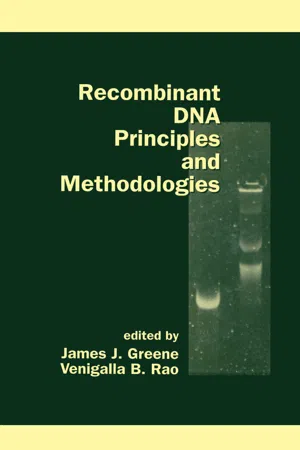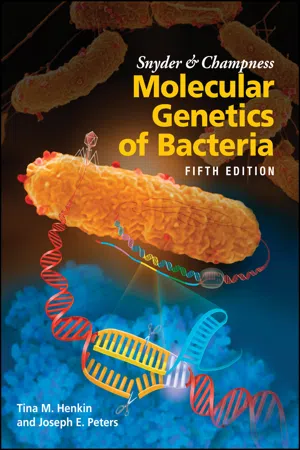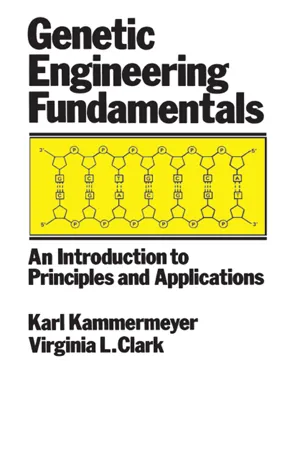Biological Sciences
Plasmids
Plasmids are small, circular DNA molecules found in bacteria and other microorganisms. They are separate from the organism's chromosomal DNA and can replicate independently. Plasmids often carry genes that provide advantages such as antibiotic resistance or the ability to metabolize certain nutrients. They are widely used in genetic engineering and biotechnology for the introduction of specific genes into organisms.
Written by Perlego with AI-assistance
Related key terms
1 of 5
5 Key excerpts on "Plasmids"
- eBook - ePub
- James Greene(Author)
- 2021(Publication Date)
- CRC Press(Publisher)
10Molecular Cloning by Plasmid Vectors
Paulina Balbás Universidad Nacional Autónoma de Mexico, Cuernavaca, Morelos, Mexico Francisco Bolívar Universidad de Estado de Morelos, Cuernavaca, Morelos, MexicoI. INTRODUCTION
Plasmids are circular, covalently closed, extrachromosomal, self-replicating, and naturally occurring DNA molecules that can be isolated as genetic entities. They range in size from 1 to more than 200 kb and are present in a wide variety of prokaryotic and eukaryotic organisms, but are mainly in bacteria. Plasmids are usually identified with functions such as those encoded by genes for drug resistance (R factors), self-transmissibility (F factors), and bacteriocin production (colicinogenic factors). They are also responsible for nitrogen fixation in certain bacteria, the resistance to heavy metals and radiation, the production of certain endonucleases, the metabolism of compounds such as toluene and camphor, plant tumor development, and the production of bacterial virulence determinants. The genetic determinants encoded by Plasmids enable their bacterial hosts to survive better in adverse environments and to compete better to occupy ecological niches. However, Plasmids are rarely essential for bacterial survival (Crosa et al. 1994; Helinsky et al. 1985).The term plasmid was used originally to describe all extrachromosomal hereditary determinants (Lederberg 1952). Plasmids became model systems for the study of DNA structure and various generalized biological processes involving DNA such as transcription, DNA replication, and genetic rearrangements. Since the early 1970s Plasmids have been a key element in recombinant DNA technology and they have been utilized as cloning vectors for DNA propagation within species. Naturally occurring Plasmids were extensively modified and used in combination with phage functions to produce a large variety of derivatives in two major lines of research: improvement of Plasmids for experimental performance, and plasmid construction for specific applications. The result of hundreds of creative approaches resulted in an enormous number of various types of Plasmids available to the scientific community in just a decade (Balbas et al. 1986; Pouwels et al. 1985; Rodriguez and Denhardt 1988). This assembly of sophisticated plasmid vectors strongly influenced the methodological developments that occurred in molecular biology during the 1980s, until the advent of PCR technology displaced much of the emphasis on plasmid vector development in the 1990s (Mullis et al. 1986). This chapter will deal mainly with generalities about E. coli - eBook - ePub
Molecular Biology
Academic Cell Update Edition
- David P. Clark(Author)
- 2012(Publication Date)
- Academic Cell(Publisher)
16 PlasmidsSummary
Plasmids are autonomous self-replicating molecules of DNA that reside inside living cells. These pieces of DNA are considered replicons because they possess origins of replication so they can be maintained from one generation to the next. Even though they are autonomous, Plasmids do not survive outside their host. Inside the host, there are a limited number of copies of plasmid DNA called copy number which depends on the type of plasmid. The more copies of a single plasmid, the more copies of the genes they encode. In some cells, Plasmids confer easily identifiable phenotypes such as antibiotic resistance, and in other hosts, cryptic Plasmids have no identifiable phenotype. Some Plasmids have transferability, or the ability to direct their movement from one cell to another, such as the F plasmid of E. coli. Other Plasmids need help to move from cell to cell, and these are called mobilizable because other Plasmids provide the mechanism to move and these cells exploit it. Other Plasmids cannot be moved from cell to cell at all. Plasmids fall into different families based on structures, and therefore, incompatibility between Plasmids occurs. When a cell has two incompatible Plasmids, one of them is lost during cell division. On the other hand, two compatible Plasmids can coexist in one host without any issue. In some rare instances, Plasmids are linear or made of RNA such as those of Borrelia, Streptomyces , and some plants or fungi.Plasmid replication occurs with each cell division, and can either be normal bi-directional replication which is similar to bacterial chromosome replication, or rolling-circle replication. In rolling circle replication, one strand of the DNA helix is nicked or cut at the origin, and this single-stranded region starts pulling away. The other circular strand also moves in the opposite direction, but since this piece is circular, it rolls. DNA replication starts at the origin of the circular parental copy, and continues around the circle to the end. The other parental strand is fully unrolled, and in some Plasmids, this piece is cut from the other structure, a second strand is synthesized and religated into a circle. In other cases, the original circular parental plasmid continues to roll, releasing more and more copies. Each copy is replicated, spliced into genome sized units, and circularized. In this scenario, one round of replication can make hundreds of copies. - Tina M. Henkin, Joseph E. Peters(Authors)
- 2020(Publication Date)
- ASM Press(Publisher)
4 Plasmids- What Is a Plasmid?
- Naming Plasmids
- Functions Encoded by Plasmids
- Plasmid Structure
- Properties of Plasmids
- Replication
- Functions of the ori Region
- Plasmid Replication Control Mechanisms
- Mechanisms To Prevent Curing of Plasmids
- The Par Systems of Plasmids
- Plasmid Cloning Vectors
- Examples of Plasmid Cloning Vectors
- Broad-Host-Range Cloning Vectors
- BOX 4.1 Linear Chromosomes and Plasmids in Bacteria
- BOX 4.2 Determining the Inc Group
- BOX 4.3 Toxin-Antitoxin Systems and Plasmid Maintenance
Electron photomicrograph of the first plasmid used for DNA cloning, pSC101 (see Cohen SN , Suggested Reading).What Is a Plasmid?
Bacterial cells often contain Plasmids , in addition to the chromosome. Plasmid DNA molecules are found in essentially all types of bacteria and, as discussed below, play a significant role in bacterial adaptation and evolution. They also serve as important tools in studies of molecular biology. We address such uses later in this chapter.Plasmids, which vary widely in size from a few thousand to hundreds of thousands of base pairs (bp) (a size comparable to that of the bacterial chromosome), are most often circular molecules of double-stranded DNA but can also be linear. The number of copies per cell also varies among Plasmids, and bacterial cells can harbor more than one type of plasmid at a time. Thus, a cell can harbor two or more different types of Plasmids, with hundreds of copies of some plasmid types and only one or a few copies of other types.Like chromosomes, Plasmids encode proteins and RNA molecules and replicate as the cell grows, and the replicated copies are usually distributed into each daughter cell when the cell divides. Plasmids even share some of the same types of functions for accurate partitioning (Par functions) and site-specific recombinases with the host chromosome (see below). By one definition, any independently replicating element in the cell that does not contain genes essential for bacterial growth (the so-called housekeeping genes) is called a plasmid. Plasmids probably persist because they very often provide gene products that can benefit the bacterium under certain circumstances. Consequently, isolates of bacteria taken from the environment often will lose some or all Plasmids over time when cultured in the laboratory. There are a number of examples where a plasmid has taken on many of the attributes of a chromosome, such as larger size and encoding multiple housekeeping genes. For example, the pSymB plasmid of some Sinorhizobium species is about half as big as the chromosome and carries essential genes, including a gene for an arginine tRNA and the minCDE genes involved in division site selection. Also, Vibrio cholerae has two large DNA molecules, both of which carry essential genes. Agrobacterium tumefaciens has two large DNA molecules, one circular and the other linear, both of which carry essential genes. In cases where a plasmid is almost as big as a chromosome and carries essential genes, which one is the chromosome and which is a plasmid? In all known cases, one of the large DNA molecules has a typical bacterial origin of replication with an oriC site and closely linked dnaA, dnaN, and gyrA genes (among others), while the other DNA molecule has a typical plasmid origin with rep ABC-like- eBook - ePub
Genetic Engineering Fundamentals
An Introduction to Principles and Applications
- John Kammermeyer(Author)
- 2017(Publication Date)
- CRC Press(Publisher)
6 Plasmids, Viruses, and Microbial Hosts—VectorsThe relationship of Plasmids, viruses, and bacterial hosts is an intimate one and frequently constitutes a cyclic event. For instance, one cultures Escherichia coli bacilli to obtain the Plasmids contained in the cell, then removes these Plasmids and uses them as a vector to convert them into a recombinant structure, and finally reintroduces the new plasmid back into E. coli bacteria as the microbial host for cloning. When a viral phage is used, the procedure is slightly different, in that the viral DNA or RNA is isolated, recombinantly modified, and then inserted into a bacterial host for cloning.PlasmidsA concise definition of Plasmids, as presented for instance by Bernard and Helinski (1 ), states that they are “extrachromosomal, self-replicating and stably-inherited nucleic acid molecules always existing as double-stranded DNA.” Plasmids are predominantly circular elements, perhaps better said looped structures. However, some linear Plasmids were reported in 1979 (2 ) and 1981 (3 ). The most recent account is that of Hirochika and Sakaguchi (4 ), who sequenced linear Plasmids isolated from Streptomyces spp.Plasmid CulturingBacterial stocks are usually maintained at -70°C. When a culture is to be prepared for laboratory growth, a number of flasks, 500 ml to 1 liter size, are filled partially with the growth medium or broth. The flasks are then inoculated with the stock culture. A frequently used bacterium is E. coli - eBook - PDF
- Martin Schleef(Author)
- 2008(Publication Date)
- Wiley-Blackwell(Publisher)
I List of Co~tributors Wolfgang Schumann Institut fur Genetik Universitat Bayreuth D-95440 Bayreuth Germany [email protected] Colin Smith MOLOGEN Berlin Fabeclcstrasse 30 D-14195 Berlin Germany [email protected] Heiko E. von der Leyen Cardion AG Max-Planck-Strasse 15a D-40699 Erkrath Germany [email protected] Ralf Wagner Institut fur Medizinische Mikrobiologie und Hygiene Universitat Regensburg Franz-Josef StrauB Allee 11 D-93053 Regensburg Germany and geneart GmbH BioPark Regensburg Josef-Engert-Strasse 9 D-93053 Regensburg Germany Ralf.Wagner @ geneart.de - Dagmar Wirth Abteilung fur Genregulation and Differenzierung GBF - Gesellschaft fur Biotechnologische Forschung Mascheroder Weg 1 D-38124 Braunschweig Germany [email protected] Burghardt Wittig Abteilung fur MoleICularbiologie und Bioinformatik Fachbereich Humanmedizin Freie Universitat Berlin Arnimallee 22 D-14195 Berlin Germany and MOLOGEN Berlin Fabeclcstrasse 30 D-14195 Berlin Germany [email protected] In the text corresponding authors are marked with an asterisk. 1 The Biology of Plasmids Wolfgang Schumann 1 Introduction: What are Plasmids? Plasmids are autonomously replicating entities which can be found essentially in all bacterial species and which play a significant role in bacterial adaptation and evolution. Furthermore, Plasmids are studied for their own sake and serve as im- portant tools in studies of molecular biology. Plasmids are normally circular, al- though linear forms have also been described and vary widely in size from 1 kb to 200 kb. Larger Plasmids of up to 1,000 kb termed megaPlasmids have also been identified. The copy number per chromosome also varies among Plasmids, and bacterial cells can carry more than one type. Like chromosomes, Plasmids code for RNA molecules and proteins, replicate as the cell grows, and equal numbers are normally distributed to the two daughter cells upon cell division.
Index pages curate the most relevant extracts from our library of academic textbooks. They’ve been created using an in-house natural language model (NLM), each adding context and meaning to key research topics.




